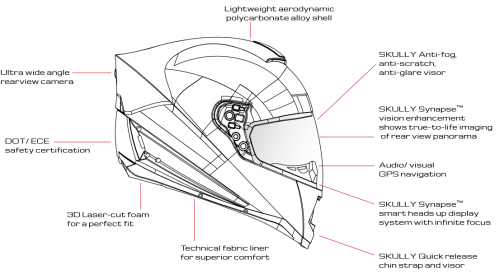If you’re into motorcycle gadgets, you’ve probably heard of the Skully helmet. The Skully AR-1 basically packs a heads-up display, rear-facing camera and GPS navigation to keep motorcyclists safe. The San Francisco-based startup just nabbed $11 million in Series A funding, proving that a wearable computer can still excite investors, even after the failure of Google Glass.

The Skully AR-1
The AR-1 may be the most anticipated motorcycle helmet ever produced. When the company released a video of the prototype last year, they got over 100,000 beta test applications in just a couple of weeks. Then they launched a crowdfounding campaign on Indiegogo last August. The result: one of the most successful campaigns in the history of Indiegogo and a total amount of $2,444,926. And at last: a couple of weeks ago, Skully announced that they raised $11 million in Series A equity to get what Skully calls “the world’s smartest motorcycle helmet” into production. Companies that were participating in the campaign include Walden Riverwood Ventures, Intel Capital, Formation 8, Techstars, and Western Technology Investments. The startup is also in the midst of hiring a bunch of software and hardware engineers to help with the manufacturing process.

It has a built-in GPS system
Are you interested in a motorcycle GPS? See the TomTom RIDER Motorcycle GPS Navigator with Lifetime Maps
So why is this helmet so special? The AR-1 (AR stands for Augmented Reality) packs a series of new features that are all designed to keep you as a rider safe. It is the first motorcycle helmet that has a HUD system. Its two main features are its 180-degree, rear-facing camera, and a little screen placed in the bottom right portion of your field of view. Thanks to this screen, you see everything that happens behind you, no matter which direction your helmet is facing.

The main features
The AR-1 features a GPS navigation. For this, Skully has developed its own interface that brings basic pieces of information to the screen. The helmet also has Bluetooth connection so you can pair it with your phone. The guys at Skully say that they are also working on their own voice-recognition software. We love the idea of the electronic tinting visor – with the press of a button on the side of the face shield, the AR-1 visor toggles between nighttime-clear and daytime-shaded but there’s a also built-in ambient light sensor that tints automatically.
Of course, all these electronics will demand battery power but that doesn’t mean that the AR-1 is heavy: it is around 180 grams heavier than a Shoei RF-1200, comparable in weight to a Schuberth modular unit. According to Marcus Weller, co-founder of Skully, you don’t have to charge the helmet very often. Depending on how much you ride, it can last a week or two before you have to plug it in. That sounds promising but the AR-1 is still months away from hitting the market.
Part of the $11 million that Skully just secured will go towards funding the manufacturing. Skully says it is hoping to start sending them out to early backers soon. The AR-1 will be produced in Northern California, but no further details were available.“There are a lot of expenses involved in the manufacturing part of it. Funds from this round will help carry SKULLY through its manufacturing milestones and accelerate our technology roadmap,” Weller said. The AR-1 will be available in sizes S-XXL and in matte black or gloss white color. Price tag: $1499.00. Estimated delivery: July 2015. Naturally, those Indiegogo contributors will be the first people to get helmets.
And what about the failure of Google Glass? “Glass was an experiment to see if people were ready for that particular form factor, and Google got its answer, which is not yet,” says Weller. “But there’s no question that interesting optics options are on the horizon.” I guess we’ll see if he’s right soon enough.
Are you interested in a more classic helmet? See the Shoei RF-1200 Helmet

